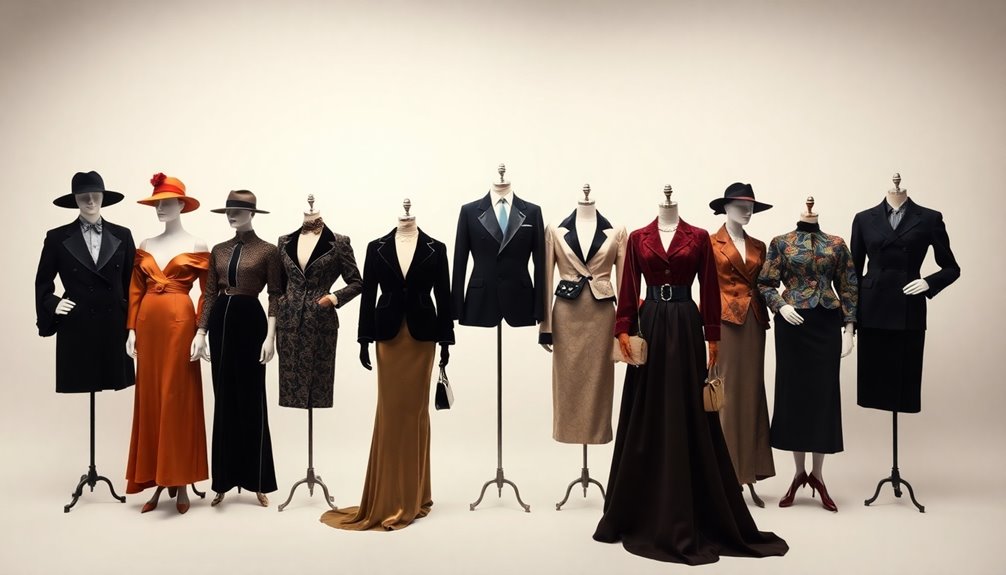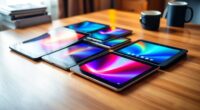Yves Saint Laurent's evolution in fashion began with his family's artistic influence and early creative endeavors. Overcoming bullying in school, he honed his skills in couture and garnered attention at just 17. His groundbreaking designs, like the Le Smoking tuxedo suit, transformed women's fashion by blending gender norms and practicality. As his legacy persists, the YSL brand continues to celebrate diverse beauty and innovation. Explore further to uncover more about his lasting impact on the fashion world.
Key Takeaways
- Yves Saint Laurent's early life in a privileged Algerian family fostered his passion for design and creativity, shaping his future in fashion.
- His education at L'École de la Chambre Syndicale de la Couture Parisienne refined his skills, leading to a significant role at Christian Dior.
- After Dior's death, Saint Laurent revolutionized women's fashion with his ready-to-wear collections, making high fashion more accessible.
- He introduced groundbreaking designs like the Le Smoking tuxedo suit, challenging gender norms and redefining femininity in the 1960s.
- The YSL brand, under Anthony Vaccarello, continues to celebrate Yves's vision of diversity and innovation in contemporary fashion.
The Mathieu-Saint-Laurent Family
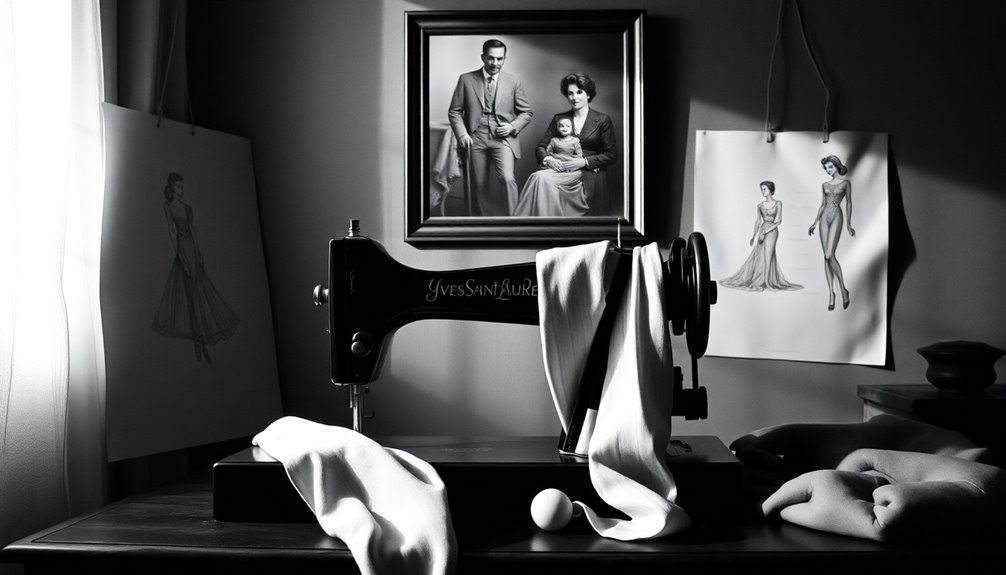
The Mathieu-Saint-Laurent family, who fled Alsace for Algeria in 1870, established themselves among Oran's elite, primarily composed of judges.
Charles managed an insurance company and owned cinemas, while Lucienne raised their three children: Yves, Michèle, and Brigitte.
Their home at 11 rue Stora fostered a joyful atmosphere, enriched by the refined lifestyle of their community.
Yves was deeply influenced by his parents' kindness and the artistic environment created by Lucienne's friends.
This nurturing space allowed his early creative expressions to flourish.
The family's subscription to fashion magazines further fueled Yves's passion for design, laying the groundwork for his future as a renowned fashion designer.
Their supportive family dynamic was essential in shaping his iconic career.
The Family Home

Nestled at 11 rue Stora in the Plateau Saint Michel neighborhood of Oran, the Mathieu-Saint-Laurent family home played a pivotal role in shaping Yves Saint Laurent's early life.
This large house, where his parents lived on the ground floor and his uncles' family resided above, created a close-knit atmosphere. As part of Oran's affluent class, Yves experienced a lifestyle marked by privilege.
His father, Charles, managed an insurance company and owned cinemas, which exposed Yves to the city's elite. The joyful environment fostered by his mother and her friends allowed him to observe refined social interactions.
Summers spent in Trouville further enriched his social experiences, influencing his artistic vision and shaping the man he'd become.
Junior High School
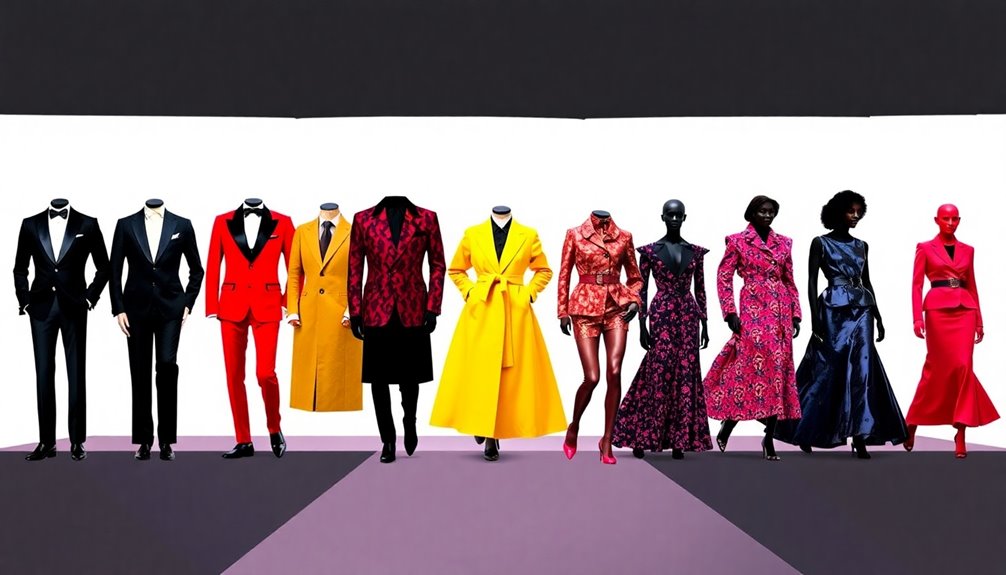
Although attending a strict Catholic school during his junior high years was challenging, Yves Saint Laurent found a refuge in creativity.
Battling bullying and exclusion shaped his self-esteem, but it was through design that he flourished. You can see how he channeled his experiences into art, creating miniature theaters and designing paper dolls with elaborate wardrobes.
At just 17, Yves gained early recognition in fashion by winning third prize in the Secrétariat International de la Laine competition in Paris. This moment marked a significant step for the budding designer, as his upbringing influenced his unique perspective on style—a blend of aesthetics, irony, and social commentary.
These formative years laid the groundwork for his future as a revolutionary fashion designer.
L'école Des Femmes: a Theatrical Revelation
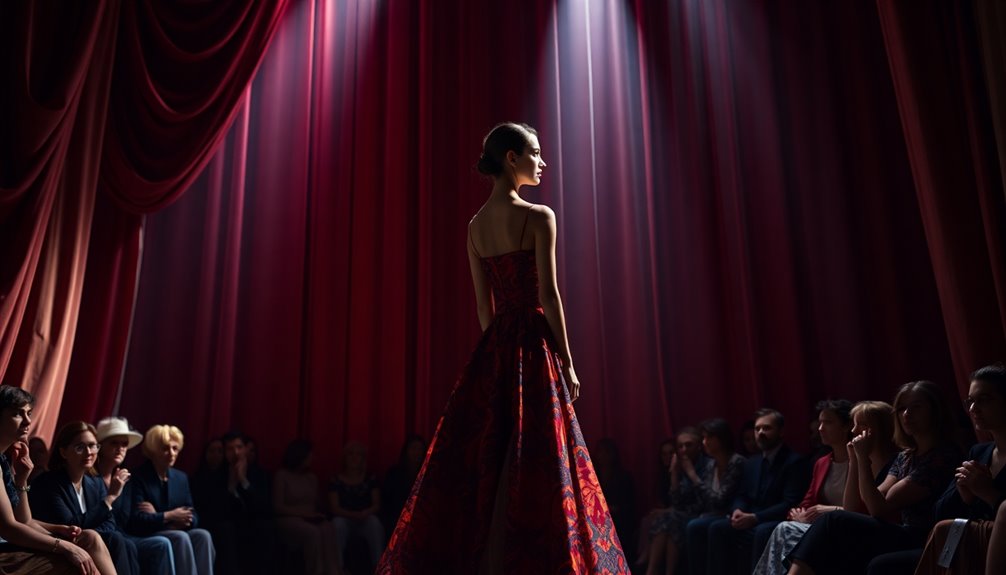
When you think about Yves Saint Laurent's artistic journey, attending "L'École des femmes" in 1950 stands out as a transformative moment.
The rich costumes and sets designed by Christian Bérard sparked his imagination and ignited his passion for theater.
This experience not only shaped his design aspirations but also laid the groundwork for his future in fashion.
Influential Theater Experience
Yves Saint Laurent's experience at Molière's "L'École des femmes" in May 1950 was nothing short of a creative awakening. Witnessing the vibrant sets and costumes designed by Christian Bérard sparked his passion for theater and design, leading him to create L'Illustre Théâtre. There, he showcased cardboard characters dressed in his mother's old dresses, merging creativity with fashion. This pivotal moment not only highlighted the importance of aesthetics in his life but also laid the groundwork for his transformative contributions to the fashion industry. The interplay of color accuracy in theater design further influenced his approach to fashion, emphasizing the significance of visual elements.
| Influence | Impact on Yves Saint Laurent |
|---|---|
| Theater | Cultivated creativity |
| Design | Refined artistic expression |
| Aesthetics | Shaped his fashion philosophy |
| Miniature theater | Practiced innovative storytelling |
| Fashion | Revolutionized the industry |
Artistic Awakening Moment
Attending Molière's "L'École des femmes" in May 1950 was a pivotal experience that transformed Yves Saint Laurent's artistic vision.
The performance, directed by Louis Jouvet and adorned with sets and costumes by Christian Bérard, sparked an artistic awakening within him. Inspired by the theatricality and creativity of the production, Yves crafted a miniature theater, L'Illustre Théâtre, using a wooden crate and cardboard characters dressed in his mother's old fabrics.
This early creative expression revealed his desire to blend art with fashion, showcasing his sensitivity to aesthetics and imaginative storytelling.
The experience marked a turning point, propelling him toward a career in the arts and ultimately leading him to establish his groundbreaking fashion house.
Impact on Fashion Aspirations
The experience at Molière's "L'École des femmes" ignited a profound shift in Yves Saint Laurent's fashion aspirations, merging the worlds of theater and design.
Inspired by Christian Bérard's theatricality, you can trace how this performance sparked his passion for storytelling through fashion.
His creation of L'Illustre Théâtre, featuring cardboard characters dressed in fabric from his mother's old dresses, showcased his early artistic vision.
This engagement with theatrical aesthetics not only enriched his creative expression but also laid the groundwork for his future innovations in the fashion industry.
As he continued to incorporate dramatic elements into his designs, Yves Saint Laurent transformed fashion into wearable art, forever influencing how people view the intersection of theater and style.
The Illustre Théâtre
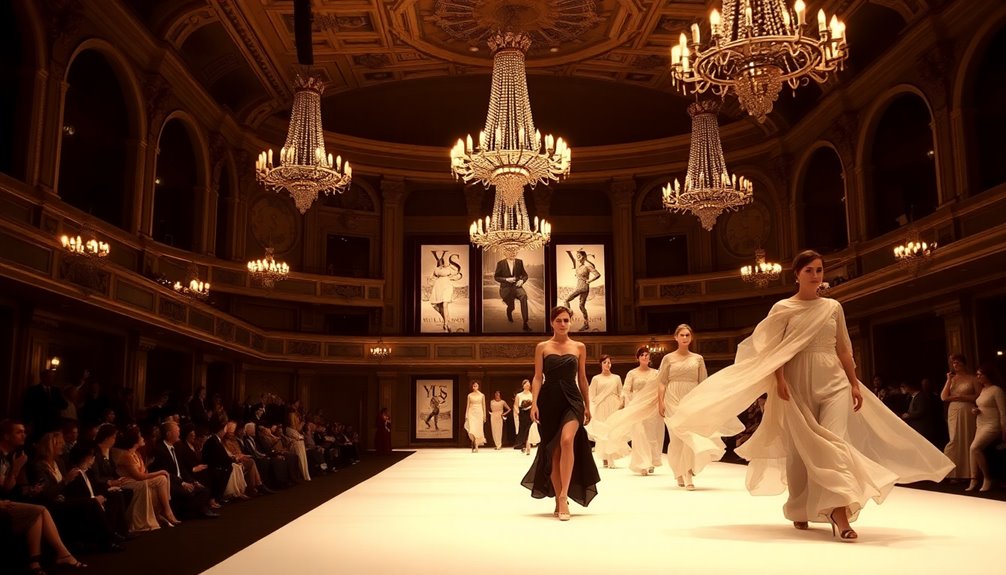
As a child, Yves Saint Laurent created a miniature theater called The Illustre Théâtre, which became an essential part of his artistic journey.
This wooden crate theater, featuring cardboard characters dressed in fabric from his mother's old dresses, sparked his passion for theater and design. Inspired by watching Molière's "L'École des femmes" in 1950, he used the Illustre Théâtre as a vibrant outlet for creative expression.
This formative endeavor allowed Yves to blend storytelling with fashion, nurturing his imagination during childhood. It helped him navigate school challenges while fostering a supportive environment for his love of creativity.
The Illustre Théâtre marked the beginning of his lifelong commitment to the arts, influencing his future career in fashion.
Early Creative Works and Fashion Aspirations

Even at a young age, Yves Saint Laurent's fascination with fashion was evident as he critiqued his mother's attire and poured over fashion magazines like Vogue and Le Jardin des Modes. His early creative works, such as satirical children's books and paper dolls, displayed his imaginative storytelling and keen aesthetic sense. By 1953, he gained early recognition in the fashion industry, winning prizes at the Secrétariat International de la Laine competition. His passion for theatre also flourished, inspiring his miniature theater, L'Illustre Théâtre.
| Year | Creative Work | Recognition |
|---|---|---|
| 1949 | Satirical Children's Book | Early Imagination |
| 1953 | Paper Dolls Collection | Third Prize |
| 1954 | Theatre Miniature | First Prize |
Career Beginnings and Opportunities
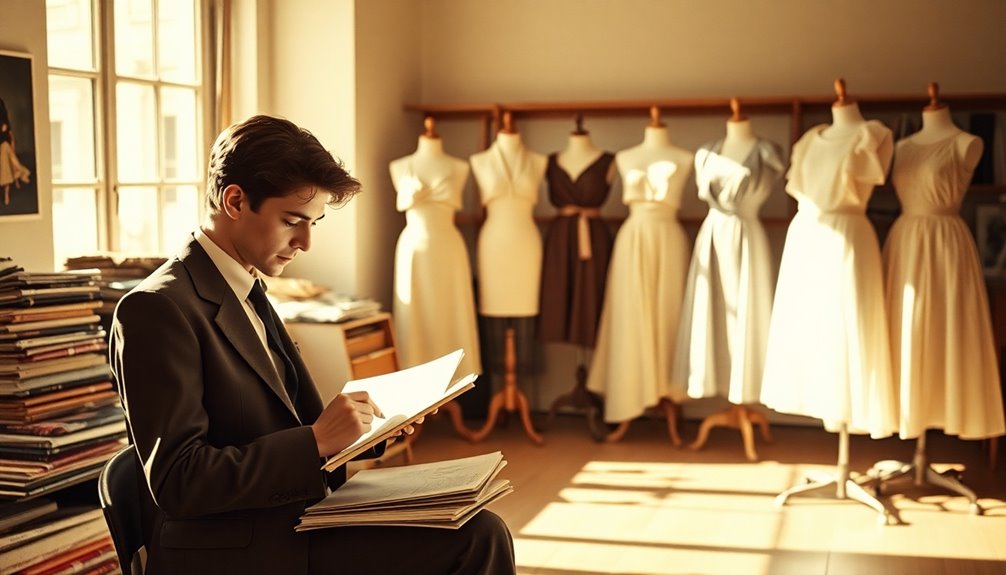
While pursuing his passion for fashion, Yves Saint Laurent seized every opportunity that came his way.
After his first visit to Paris, he met Vogue editor-in-chief Michel de Brunhoff, which sparked his ambition in the fashion world. Returning to Oran, he enrolled at L'École de la Chambre Syndicale de la Couture Parisienne in 1954, refining his couture design skills.
By 1955, his impressive illustrations caught the eye of Christian Dior, landing him a position as an assistant designer the following year. His talent shone brightly as he won multiple awards at the Secrétariat International de la Laine annual competition.
Just two years later, Yves became Dior's successor after the legendary designer's death, setting the stage for his transformative influence on women's fashion.
Legacy and Influence
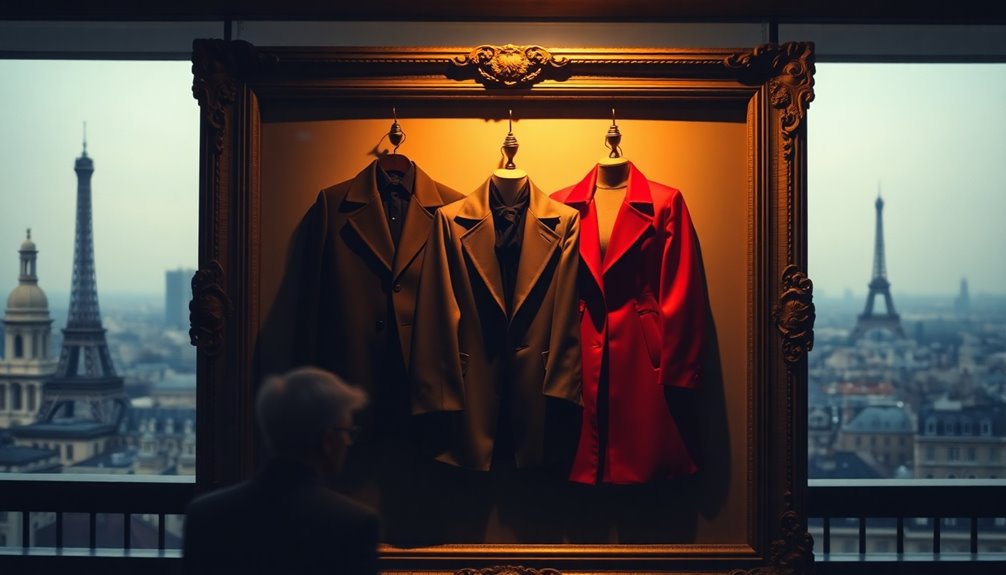
Yves Saint Laurent's ascent from a young designer to a fashion icon marked the beginning of a legacy that continues to resonate today. He revolutionized high fashion with his 1966 ready-to-wear collections, making it accessible to a broader audience.
By introducing gender fluidity through the iconic Le Smoking tuxedo suit, he challenged established gender norms and redefined femininity in the 1960s. His groundbreaking designs, like the Mondrian dress and sheer blouses, paved the way for contemporary trends that emphasize comfort and practicality.
Even today, the YSL brand, led by Anthony Vaccarello, embodies the spirit of innovation and diversity that Yves Saint Laurent championed, ensuring his influence remains essential in the global luxury fashion market. His work is often celebrated within the realm of haute couture craftsmanship, highlighting the intricate details that define high fashion.
Frequently Asked Questions
What Is the History of the Yves Saint Laurent Brand?
The history of the Yves Saint Laurent brand begins in 1961 when you see Yves and Pierre Bergé launch their fashion house.
You notice the revolutionary ready-to-wear collections debuting in 1966, making high fashion accessible.
You can't miss the iconic "Le Smoking" tuxedo for women, which challenges gender norms.
As the first to showcase diverse models on runways, the brand breaks barriers, and even today, it remains influential under Anthony Vaccarello's direction.
How Did Yves Saint Laurent Impact the World?
Yves Saint Laurent's impact on the world of fashion is undeniable.
You see, he challenged traditional gender norms by introducing women's tuxedo suits, promoting gender fluidity. His ready-to-wear collections made high fashion accessible, breaking down barriers for everyday women.
Plus, he championed diversity by featuring models from various backgrounds, pushing for greater representation.
Who Is Saint Laurent in the Bible?
When you explore the pages of the Bible, you won't find a figure named "Saint Laurent."
Instead, the name echoes the story of Saint Lawrence, a courageous martyr known for his unwavering faith. He faced torture with defiance, famously saying, "You may roast me, but I won't deny my God."
His legacy lives on, celebrated on August 10th, reminding you of the strength found in steadfast belief amid persecution.
What Inspired YSL?
Yves Saint Laurent's inspiration came from various sources. As a child, you'd see him critiquing his mother's outfits, which sparked his passion for fashion.
His love for theater and design flourished through drawing and creating a miniature theater. Attending a performance of Molière's play ignited his interest in elaborate costumes.
Fashion magazines like Vogue shaped his understanding of style, while early competition successes validated his talent and fueled his ambition.
Conclusion
So, you see, Yves Saint Laurent didn't just design clothes; he crafted the very fabric of fashion history. Picture him as a fashion wizard, waving a magic wand over drab wardrobes, transforming them into flamboyant expressions of art. His life's a runway where each step echoes creativity and audacity. As you strut through the world, remember: behind every chic ensemble lies a tale of rebellion, artistry, and a sprinkle of that oh-so-fabulous Saint Laurent magic.
